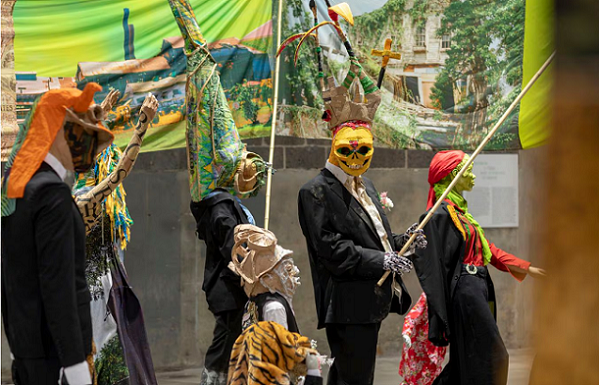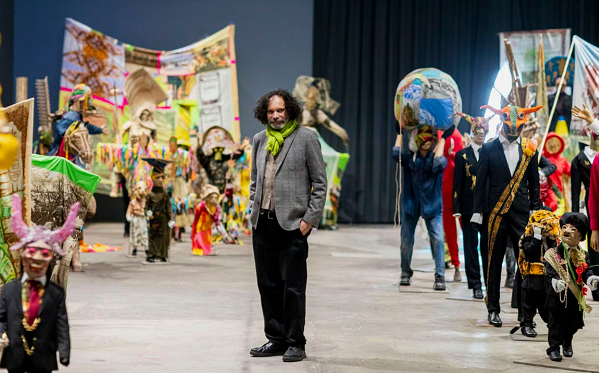Here are excerpts from Murray Whyte’s excellent review of Hew Locke’s “The Procession,” currently on view at the ICA Waterhouse in Boston, Massachusetts. He writes, “Locke’s many micronarratives add up to an imposing global epic—unsteady and still unfolding—with no end in sight.” Read the full article at the Boston Globe.
“The Procession,” a 140-mannequin mob made by the artist Hew Locke in 2022 for the Tate Britain, explodes with color and life. Just arrived at the ICA’s Watershed on Boston Harbor, it’s a riotous group, from towering superhuman idols to child-size imps; horses meander here and there through the visual din. But the scene is laced with a particular dread tailored to the artist’s primary concerns.
Raised in British Guyana and now, at 64, living in Edinburgh where he was born, Locke has led a cross-continental life that spans not just geography but the palpitations of a transnational world forever in flux. He weaves into the lively costumes and masks that his figures wear a narrative of dominance and submission, have and have not — a global dynamic begat by colonialism that still gives shape to the world we live in now.
At the far back of the parade, which snakes in clusters and bunches the half-football-field length of the Watershed, a 12-foot-tall idol looms over a child figure patched in bright colors and clutching a doll-size skeleton in a tiny canoe. Towering above, it seems almost to be herding the rest from behind, guiding their unruly march to the unknown. Its headdress — a jagged, towering thing, part military, part high-holy garb — and tunic are festooned with historical images of Jamaican sugar cane workers. Its skirting, cascading a half dozen feet from its waist, bears the blown-up imprint of a stock certificate from the West India Improvement Company, a late-19th-century American venture to build a railway to transport bananas from the Jamaican interior to boats waiting to ship them back to the US. It failed, Locke explained, because Jamaica was British territory; the colony’s spoils were meant to serve them first.
Walking the installation earlier this week, Locke, tall and rangy, with a mop of dark chin-length curls and a soft, Carribbean lilt, could offer just as full a description of each and every one of the figures here. Their references are almost always specific and deeply researched. But as a mass, they form a patchwork ensemble emblematic of the contemporary world’s lurch from a dark past to a fractious present.
Commerce and culture overlap in ugly ways; Locke is fond of historical stock certificates as tableaux for painted-on scenes of human consequence. In one grouping, stocks issued by the French Compagnie Universelle to build the Panama Canal stand as a relic of its brutality and ultimate failure (an American company finished the job); hoisted like a flag by a troupe of mysterious red-hooded figures, the stock certificate is painted with wide-eye workers terrorized by demonic masters. The skirting for another towering figure is a fabric imprinted with a $1,000 Greek Government 7th Refugee Loan of 1924, a national bond issued to raise money for the resettlement of refugees after the fall of the Ottoman Empire. Locke has painted onto its text a canoe-shaped vessel steered by weary-looking men; around them, skeletons dance in grim reverie.
But “The Procession” also implies movement more broadly, across not only oceans and continents but time and political era. “Then is now, now is then” is one of the key points Locke means to make. It should be impossible to take in this specific scene without visions of refugees from Syria in recent years crowding makeshift boats in desperate hope of making it to Greece, and farther into Europe.
Locke himself embodies the rough to-and-fro of global exchange. His father, the artist Donald Locke, was Black and Guyanese, born there in 1930 while it was a British colony; he moved to the UK in 1954 on a British Council Scholarship to study art. There he met Locke’s mother, the artist Leila Locke, who was British and white; Locke was born in Edinburgh in 1959. In 1966, the family moved to a Guyana on the cusp of independence. [. . .]
Independence, when it came, brought both hope and chaos — untethered from the UK, an independent Guyana, almost exclusively agrarian and resource-poor, was suddenly forced to grapple alone with its intense poverty. The recent discovery of offshore oil and gas has given the country a sudden rush of wealth and global investment — “the new Dubai,” some have said, just the kind of paradox that is Locke’s favorite raw material. Those tensions — historical and ongoing — shaped his world view, and still do.
Tangled up in all of it are the people who neither benefit from nor are immune to the relentless assault of global commerce. It’s not insignificant that “The Procession” is in implied motion; start at the back and work your way forward and you’ll feel its churn. Mass movements of people over generations and centuries have been both willing and not. “The Procession” is explosively jubilant in color, material, and form; but Locke’s counterweight of history thrusts its carnival and pageantry into deeper readings about dispossession and displacement.
Read it as you will, but I can’t look at “The Procession” without thinking of the masses of migrants gathering at the southern border. I think of the Darién Gap between Colombia and Panama, a dangerous pass where countless thousands have dragged themselves through jungle and knee-deep mud just to get close enough to the United States to see it, and hope.
For full article, see https://www.bostonglobe.com/2024/05/23/arts/review-of-hew-lockes-exhibition-at-ica-boston-watershed/
[Photos above by Mel Taing: Installation view, Hew Locke: The Procession, the Institute of Contemporary Art/Boston, 2024.]



One thought on “At ICA’s Watershed, Hew Locke’s rough pageant of humanity”